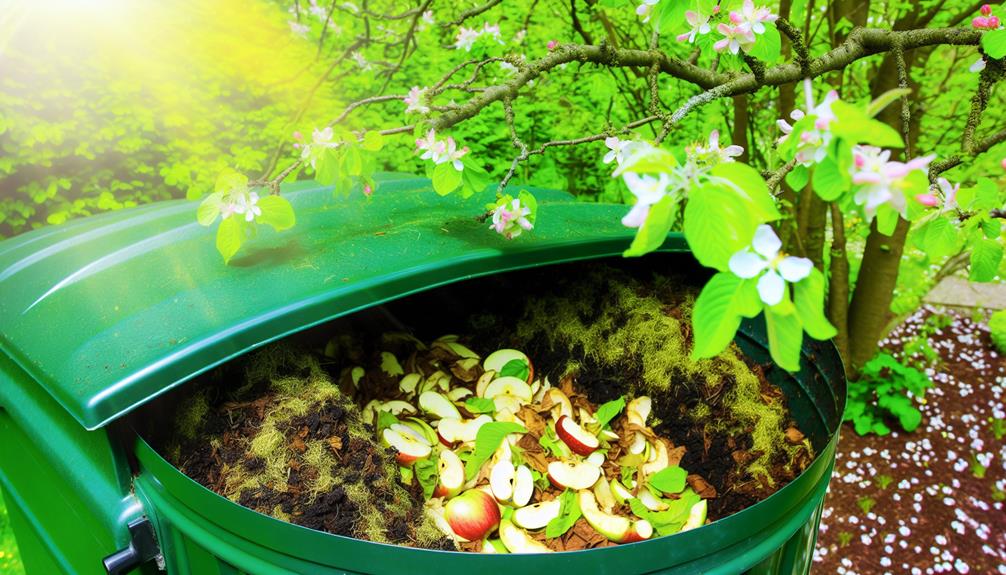

Yes, you can compost apples to enrich your soil with essential nutrients like potassium, phosphorus, and nitrogen. Make sure to chop the apples into smaller pieces for faster decomposition. Remove any stickers before adding them to your compost. Mix the apple scraps with brown materials like dried leaves or shredded paper to maintain balance and keep the pile healthy.
Be mindful of potential issues like fruit flies and rodents, and turn your compost regularly to improve aeration and breakdown speed. By taking these steps, you’ll optimize your composting results and enhance your garden’s nutrient profile. Learn more effective strategies for successful composting.
Composting apples can greatly enrich your soil by adding essential nutrients and improving its structure. When you compost apples, you’re contributing to the creation of humus, a rich, dark organic material that enhances soil fertility.
Apples break down relatively quickly, making them an excellent addition to your compost pile. Their moisture content helps maintain the right balance between green and brown materials, which is important for effective composting.
To maximize benefits, chop up the apples into smaller pieces before adding them to your compost bin. This speeds up decomposition and ensures more even distribution of nutrients. Remember to mix them well with other compostable materials to avoid clumping and to maintain aeration.
With proper composting practices, your garden will thrive.
Also Read: Can You Compost Azuki Beans?
By adding apples to your compost, you’re providing a vital source of essential nutrients like potassium, phosphorus, and nitrogen. These nutrients play a significant role in improving soil health and promoting plant growth.
Apples break down relatively quickly, releasing their nutrients into the compost. This process helps create a balanced and nutrient-dense compost mix.
Here are three key benefits:
Make sure to chop the apples into smaller pieces to accelerate decomposition. Mix them well with other compost materials for the best results.
When choosing apples for composting, you can use any variety, whether they’re fresh, bruised, or even past their prime. Apples are rich in nitrogen, which makes them a valuable addition to your compost heap.

You don’t need to worry about specific types; both common varieties like Granny Smith, Fuji, or Gala, and heirloom types work just as well. Even if the apples are slightly moldy or overripe, they still break down efficiently. Organic or non-organic, all apples can be composted.
Just remember, whole apples take longer to decompose compared to smaller pieces. It’s a great way to reduce food waste and enrich your compost, contributing essential nutrients that will benefit your garden soil.
Also Read: Can You Compost Bacon Grease?
To prepare apples for composting, follow these steps:
Peeling off those pesky apple stickers is a crucial first step in prepping your apples for composting. These stickers are often made of plastic or other non-biodegradable materials that can harm your compost.
Here’s how to make sure your apples are sticker-free:
Now that your apples are sticker-free, it’s time to chop them into smaller pieces to speed up the composting process. Smaller pieces break down faster, making it easier for microorganisms to do their job.
Start by cutting the apples into quarters, then slice each quarter into smaller chunks. Aim for pieces about an inch or smaller in size. This increases the surface area, allowing for quicker decomposition. You don’t need to be precise; just make sure the pieces aren’t too large. Using a sharp knife will make the task easier and safer.
Balancing your chopped apples with an equal amount of brown materials is essential for efficient composting. Browns are carbon-rich materials that help regulate moisture and provide structure to your compost. When you add apples, balance them with items like dried leaves, straw, or shredded paper.
Here’s a quick list of brown materials you can use:
Mix these browns thoroughly with your apples to establish a balanced compost pile that decomposes efficiently.
Also Read: Can You Compost Cotton Balls? The Shocking Truth Revealed!
One potential issue with composting apples is the attraction of pests such as fruit flies and rodents. These pests are drawn to the sweet smell and the moisture content of decomposing apples. Fruit flies can quickly multiply, creating a nuisance around your compost bin. Rodents, on the other hand, might be tempted to dig into your pile, looking for an easy meal.
If not managed properly, these pests can disrupt the composting process and potentially spread diseases. Additionally, the excess moisture from apples can lead to an imbalance in your compost, causing it to become too wet and smelly. Proper management is key to ensuring your compost pile remains healthy and effective without attracting unwanted pests.
To keep pests away from your compost, make sure that apple scraps are buried deep within the pile. This deters critters from detecting the smell and reduces the risk of infestation.
Additionally, always cover fresh food waste with a layer of brown materials like leaves or straw, which helps mask odors.
Here are three key tips to avoid attracting pests:
Achieving a balanced compost pile involves maintaining the right ratio of green and brown materials. Green materials, like apple peels and cores, provide nitrogen, which fuels microbial activity. Brown materials, such as dried leaves and cardboard, offer carbon, which supplies energy for microorganisms.
Aim for a mix of roughly one part green to three parts brown. This ratio helps prevent your compost from becoming too wet or too dry. Turn your pile regularly to aerate it, ensuring the microbes get enough oxygen. Keep an eye on moisture; your compost should feel like a damp sponge.
Also Read: Compost Mold Dilemma: Is It Worrisome or Worthwhile?
When composting apple by-products, start with apple peels, which break down quickly and enrich your compost with valuable nutrients.
Next, focus on the cores; they can be composted too, but might take a bit longer to decompose. Remember to chop the cores into smaller pieces to speed up the process and prevent any potential pest issues.
While composting apple by-products, you’ll find that apple peels break down relatively quickly, enriching your compost with valuable nutrients. This rapid decomposition process makes apple peels an excellent addition to your compost pile.
To maximize the benefits of composting apple peels, keep the following tips in mind:
To effectively compost apple by-products, focus on a few core techniques that will optimize the decomposition process and enrich your compost.
Start by chopping apple cores and peels into smaller pieces; this increases the surface area and speeds up decomposition.
Balance your compost by mixing these green materials with an equal amount of browns like dried leaves or shredded paper.
Make sure your compost pile stays moist but not soggy, as excessive water can slow down the process.
Turn the pile regularly to aerate it, promoting faster breakdown of organic matter.
Finally, maintain a balanced pH by occasionally adding a handful of soil or finished compost.
Following these tips will help you create rich, fertile compost from apple by-products.
Also Read: Can You Compost Balloon?
Encountering issues with your composting process can be frustrating, but many common problems have straightforward solutions. If your compost pile isn’t breaking down properly, you might need to adjust the balance of green and brown materials.

A foul odor often indicates too much moisture or insufficient aeration. To remedy these issues, consider the following steps:
With these adjustments, your compost should thrive.
To sum up, composting apples is a straightforward and beneficial practice. Make sure you prepare the apples properly, balance your compost, and manage potential pest issues.
By following these steps, you’ll enhance your compost with valuable nutrients and reduce waste. Remember, both whole apples and by-products like peels and cores can be composted effectively.
Keep an eye on common problems and adjust as needed for best results. Happy composting!
